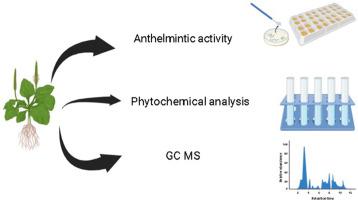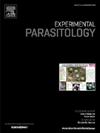In-vitro anthelmintic activity and phytochemistry of Salvia sclarea extracts against Haemonchus contortus
IF 1.6
4区 医学
Q3 PARASITOLOGY
引用次数: 0
Abstract
Haemonchus contortus –the barber's pole worm poses a critical threat to ruminant health and productivity worldwide. This is due to its high host pathogenicity and poor susceptibility to chemical anthelmintics. To address this threat, sustainable and natural solutions are needed to control its infections. This study evaluated the anthelmintic efficacy of Salvia sclarea extracts against H. contortus in comparison to reference drug – the Albendazole. The extracts were obtained in ethyl acetate, ethanol, and petroleum ether, analyzed phytochemically and subjected to in-vitro testing at different concentrations using the Adult Motility Inhibition Assay (AMIA) and Egg Hatch Inhibition Assay (EHIA). The most effective extract was ethyl acetate in terms of its 100 % worm mortality at all tested concentrations 6 h post treatment and 87.38 % inhibition of egg hatching at 2 mg/mL. The ethyl acetate extract demonstrated the greatest potency, with an LC50 of 0.22 mg/mL, compared to ethanol (LC50 = 0.55 mg/mL) and petroleum ether (LC50 = 3.66 mg/mL), confirming its superior ovicidal efficacy against H. contortus. Terpenoids, coumarins, and phenolics were the main bioactive agents present in the extract. Using complementary GC-MS profiling, prominent anti-parasitic components including Sclareol and Geranylgeraniol were identified. These findings demonstrate potential of S. sclarea as a natural substitute for synthetic anthelmintics; however, in vivo studies are needed to validate the efficacy and safety of the bio-active constituents of S. sclarea against the target parasite in host animals.

鼠尾草提取物对弯血螨体外驱虫活性及植物化学研究。
弯曲Haemonchus -理发师的杆状蠕虫对全世界反刍动物的健康和生产力构成严重威胁。这是由于它的高宿主致病性和对化学驱虫药的敏感性差。为应对这一威胁,需要可持续和自然的解决方案来控制其感染。本研究比较了鼠尾草提取物与对照药物阿苯达唑的驱虫效果。在乙酸乙酯、乙醇和石油醚中提取提取物,进行植物化学分析,并在不同浓度下进行体外测试,使用成体运动抑制实验(AMIA)和卵孵化抑制实验(EHIA)。处理6 h后,乙酸乙酯在所有浓度下的虫死亡率均为100%,在2 mg/mL浓度下对虫卵孵化的抑制率为87.38%。与乙醇(LC50 = 0.55 mg/mL)和石油醚(LC50 = 3.66 mg/mL)相比,乙酸乙酯提取物的杀卵效果最好,LC50为0.22 mg/mL,表明乙酸乙酯提取物具有较好的杀卵效果。萜类、香豆素和酚类是其主要的生物活性成分。利用互补的气相色谱-质谱分析,鉴定出主要的抗寄生虫成分包括香叶醇和香叶醇。这些研究结果表明,葡萄球菌具有作为合成驱虫药天然替代品的潜力;然而,还需要在宿主动物体内验证其生物活性成分对目标寄生虫的有效性和安全性。
本文章由计算机程序翻译,如有差异,请以英文原文为准。
求助全文
约1分钟内获得全文
求助全文
来源期刊

Experimental parasitology
医学-寄生虫学
CiteScore
3.10
自引率
4.80%
发文量
160
审稿时长
3 months
期刊介绍:
Experimental Parasitology emphasizes modern approaches to parasitology, including molecular biology and immunology. The journal features original research papers on the physiological, metabolic, immunologic, biochemical, nutritional, and chemotherapeutic aspects of parasites and host-parasite relationships.
 求助内容:
求助内容: 应助结果提醒方式:
应助结果提醒方式:


